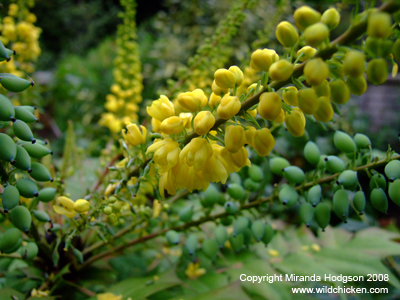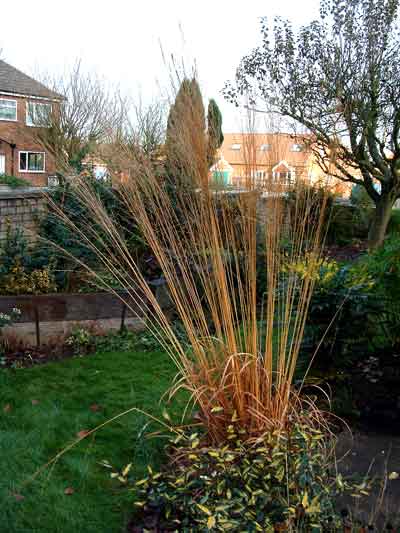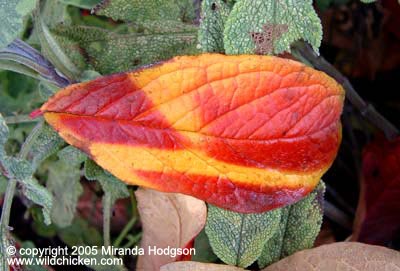December 15th 2005 - Sweet indulgence
Apologies for the delay!
Iíve been trying to get to this journal for what seems like weeks but have been constantly side-tracked by these boots, which are attempting to take over our lives at the moment. Not that Iím complaining about being so busy, just that, sometimes, itís nice to do other things.
Last week, however, I tore myself free from our little office and indulged myself in the garden for a day. How glorious to be outside again, getting my clothes dirty and scratching my arms on thorns, rather than gazing longingly out of the window.
"...you should spend plenty of time just looking at your garden and thinking about it, rather than working in it."
Had to spend a while re-familiarising myself with whatís growing at the moment before actually doing anything. It's very pleasant, walking around the garden and then just standing there staring at plants. It was Richard Bird, in his excellent book, Hardy Perennials (the book that turned me from being interested to obsessed), who said that you should spend plenty of time just looking at your garden and thinking about it, rather than working in it. He also added that if he were to rely on garden design alone, heíd probably starve because he spends so long standing and staring.
So I stared at the Mahonia x media 'Charity' for a while and admired its sprays of bright yellow flowers set against the prickly dark green leaves. Itís flowering earlier this year than last and has more flowers than it has done previously. Cutting back the main stem has improved it a lot as itís put out several new ones from lower down. In another year or two it should look quite respectable.

Mahonia x media 'Charity'
The next plant to catch my attention was a fern, Polystichum polyblepharum. There are two of these in the garden, though more may be added as they are, in my humble opinion, extremely garden-worthy. The leaves are unusually firm for a fern with such finely divided leaves, and they arch so elegantly. They're also uncommon for being glossy, so they catch the sunlight in dappled shade and light up corners of the garden that get less light. The crosiers, and then the leaf veins, are covered in fine brown scales that call for closer attention to be paid.

Polystichum polyblepharum
After that I moved on to an ornamental grass which originally arrived here tucked into the side of another grass, bought about three years ago. There was only a tiny bit of it to start with and I separated it off, potted it up and now have two good sized clumps at the back of one bed. Come spring, Iíll divide it again and make two more plants. Karlís mum says sheíd like one, so one will have her name on it.
Itís a late flowerer, this grass, and starts quite a dark green. The stems rise high above the leaves, to over 2m, and the flowers themselves open to a brownish purple. As autumn goes by, the stems and flowers lighten to a creamy yellow, while the shorter arching leaves stay green for a few more weeks. The contrast is extremely attractive and demands admiration. Catch it with the sun behind it and youíll be transfixed; moving in a light breeze, every leaf, flower and seed catches the light and the whole plant positively glows.

Molinia caerulea arundinacea 'Bergfreunde', maybe.
If it isn't, it jolly well should be.
"...it was a welcome freebie and Iím very pleased I didnít just pull it out and throw it away"
Iím not entirely sure, but think itís Molinia caerulea arundinacea, possibly ĎBergfreundeí because of its size. There are a couple of other cultivars it could be Ė ĎWindspielí or ĎKarl Foersterí - but they arenít as tall. Looking at the catalogue of the nursery the other grass came from, ĎBergfreundeí is the tallest Molinia they sell, so thatís my bet. There is another tall variety, ĎSky Racerí, but that wasnít in the catalogue, so I doubt itís that one. Whatever, it was a welcome freebie and Iím very pleased I didnít just pull it out and throw it away.
After all that standing around, I started to get a bit chilly and thought Iíd better have a go at actually doing something. Out came the rake and I started clearing leaves off the lawn. In the damper areas, the grass underneath had started to turn yellow, so it wasnít before time.
Because itís been fairly mild this winter, the grass is still growing but thereís no way it can be cut because itís so wet. Itís already as long as it might be by February or March and by the time the first cut of the 2006 comes round itíll be longer still. What to do? If I leave it long, then itíll look dreadful after that first cut, all yellow and unloved. If I try and cut it wet, some of it will get scalped, the mower will get clogged up and Iíll have to spend ages raking up clumps of wet grass. Then, for weeks and weeks, every time one of us steps on the grass weíll find the bottom of our shoes covered in bits that refuse to come off. Is it worth it?
Or, I could try an experiment. A possible option occurred to me whilst looking down at the freshly raked lawn from an upstairs window. I could rake it into patterns, as the Japanese do with their gravel gardens Ė we could have spirals and watery swirls, or go geometric and try a checker board effect. Having some sort of effect would make it look neater and save me from hearing the neighbours describe it as looking Ďruggedí again. Iíll give it a go and see what happens.

This is the sort of thing that jumps out at you when you're standing around gawking at things.
© Copyright Miranda Hodgson 2005